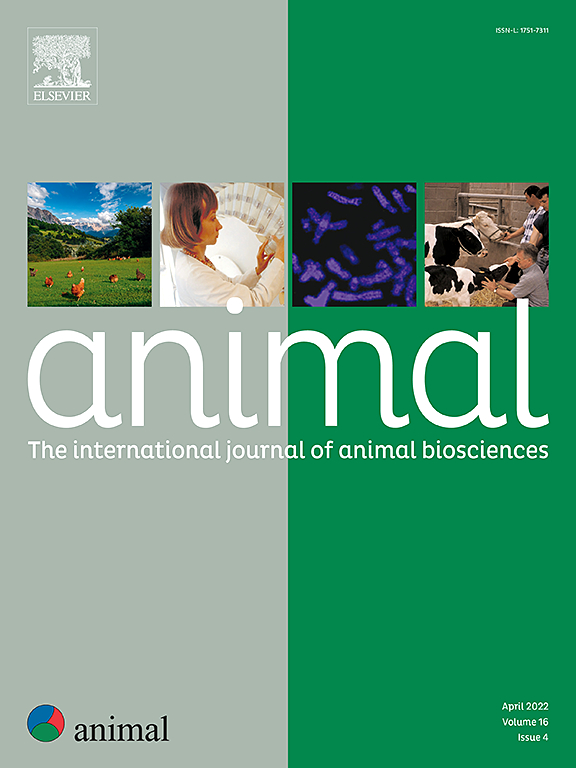Timing, risk factors, and causes of foetal and preweaning lamb mortality in lowland production systems involving a range of ewe genotypes
IF 4
2区 农林科学
Q1 AGRICULTURE, DAIRY & ANIMAL SCIENCE
引用次数: 0
Abstract
Reducing lamb mortality has production, economic and animal welfare benefits. The timing and causes of death and associated risk factors were investigated in a study conducted over 2 consecutive years (involving 1 103 and 1 038 ewes in 2017 and 2018, respectively) in three prolific (average litter size 1.91) indoor-lambing, lowland flocks (in Ireland) that consisted of a range of genotypes, managed in grass-based systems of production. Data were collected from all foetuses and lambs that died (between ∼120 days gestation and weaning at 14 weeks of age); 221 cases in 2017 and 241 cases in 2018. All cases were submitted to a Regional Veterinary Laboratory for necropsy examination using standardised protocols that were developed in advance of case submissions. The majority (60%) of lamb mortality occurred prior to or within 24 h of birth: 46% at or prior to birth and 14% within the first 24 h. Infection (32%) and dystocia (20%) accounted for over half of the mortality. Chlamydia abortus was detected more often in lambs from 2-year-old ewes lambing for the first time than in lambs from older ewes. Dystocia accounted for a statistically significant higher proportion of deaths among purebred lambs born to Texel ewes (49.4%, 95%CI (confidence interval) 36.0 – 62.9) compared to purebred lambs born to Belclare ewes (12.8, 95%CI 2.2 – 23.5). More lambs failed to yield a diagnosis of the cause of death when born to Belclare ewes (29.2%, 95%CI 17.8 – 40.6) than to Suffolk-X ewes (7.4%, 95%CI 0.1 – 14.8). About one−third of lamb mortality cases were adjudged to be preventable through more consideration of management factors during pregnancy, parturition and early postpartum. The use of good hygiene practices at lambing time and optimising lamb birth weight should reduce the level of preweaning lamb mortality in indoor lambing flocks.
求助全文
约1分钟内获得全文
求助全文
来源期刊

Animal
农林科学-奶制品与动物科学
CiteScore
7.50
自引率
2.80%
发文量
246
审稿时长
3 months
期刊介绍:
Editorial board
animal attracts the best research in animal biology and animal systems from across the spectrum of the agricultural, biomedical, and environmental sciences. It is the central element in an exciting collaboration between the British Society of Animal Science (BSAS), Institut National de la Recherche Agronomique (INRA) and the European Federation of Animal Science (EAAP) and represents a merging of three scientific journals: Animal Science; Animal Research; Reproduction, Nutrition, Development. animal publishes original cutting-edge research, ''hot'' topics and horizon-scanning reviews on animal-related aspects of the life sciences at the molecular, cellular, organ, whole animal and production system levels. The main subject areas include: breeding and genetics; nutrition; physiology and functional biology of systems; behaviour, health and welfare; farming systems, environmental impact and climate change; product quality, human health and well-being. Animal models and papers dealing with the integration of research between these topics and their impact on the environment and people are particularly welcome.
 求助内容:
求助内容: 应助结果提醒方式:
应助结果提醒方式:


